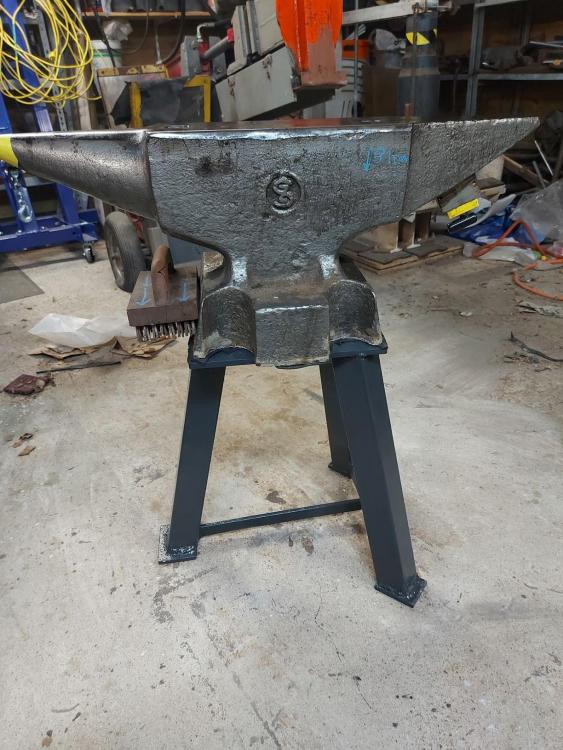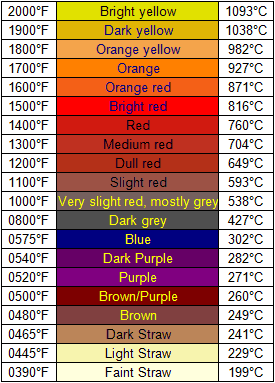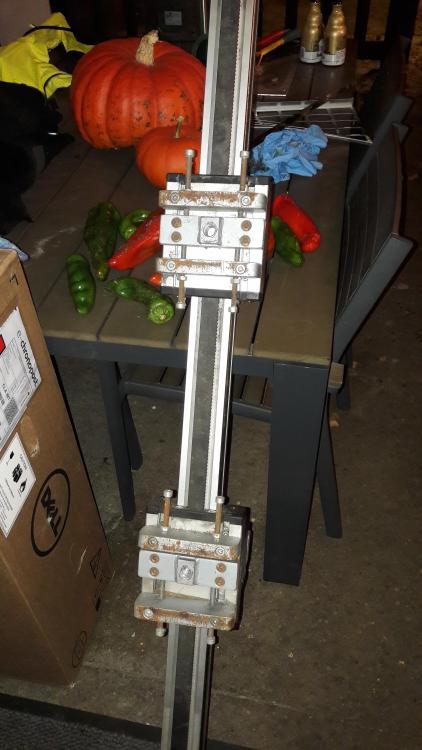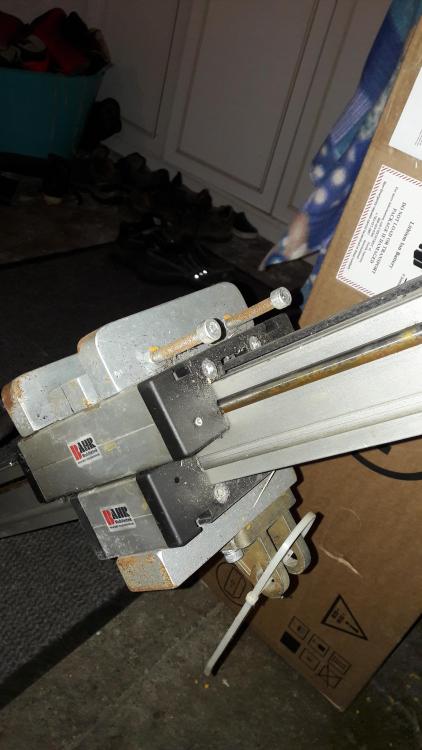
BartW
Members-
Posts
281 -
Joined
-
Last visited
Content Type
Profiles
Forums
Articles
Gallery
Downloads
Events
Everything posted by BartW
-
Pandrol clip straightening experiment
BartW replied to JHCC's topic in Blacksmithing, General Discussion
That's what I was told by someone who works for the railroads and does metallurgy. But I know these things can vary a lot and it wouldn't suprise me to have different standard in the USA compared to the EU. But on the other hand; they are basically springs. -
Pandrol clip straightening experiment
BartW replied to JHCC's topic in Blacksmithing, General Discussion
Those RR clips (springy, like simple 1084 steel) in the video above are not the same as a pandrol E-clip (high manganese, high silicon 5160 steel). -
Pandrol clip straightening experiment
BartW replied to JHCC's topic in Blacksmithing, General Discussion
I played with pandrol clips a bit, and they make great tools (punches, chisels, drifts ... ). But I found they are really sensitive to forging too cold; and they need an extensive heat treatment with many normalizing cycles to maximize performance. -
Pandrol clip straightening experiment
BartW replied to JHCC's topic in Blacksmithing, General Discussion
Great idea. I've seen you have adopted the golf-ball handle philosofy too ? -
Welcome aboard ! my 2 cents: 1. All Anvils can chip. even plain mild steel can chip over time with enough deformation. 2. Don't get blinded by the HRC value. Steel quality and edge radius are much more important. I have a glass hard anvil with sharp edges; and I haven't been able to chip it (and I tried). Reason; this is a professionally hardened 1.2379 aka D2 press block for stamping things. I have some skoda(s), some UAT and some ancient anvil from 1908. The skoda's are cast tool steel and ridiculously hard; yet I haven't been able to chip it. The corners are radiussed, and the previous owners did chip it. The 1908 anvil will baely scratch with a file; but even that has chipping damage. So could you chip a modern anvil? YES. But if you use your tool wisely, it won't chip, and the anvil will serve you and the generations after you.
-
Welded steel tripod for the 150 kilo/ 330 pound skoda. Half inch baseplate out of steel; 2.5 inch thick wall square tube legs at 14° angle, filled with dry sand and ash. I reinforced the baseplate; and the anvil is screwed down with 4 M16 bolts. there's a leather liner inbetween the stand and the anvil. it's more quiet than the original wooden stand. I love it. The picture is strange, it looks like the legs too straight down, but the wooden base was narrower.
-
Anvil stand legs; what's best ?
BartW replied to BartW's topic in Stands for Anvils, Swage Blocks, etc
you're right; "best" without context is meaningless. In my case; i'd like it to be as silent as possible. and strong enough to support a 400 pound anvil. -
Hello; Quick question; I've been using 60 mm square tube with 3 mm walls; But I've also seen round tube; H-beams, U-beams, angle iron, 20 mm thick iron; 30mm solid iron ... So what would be best suited ? For an anvil tripod stand welded together. greetings, Bart
-
Metal tempering without an oven
BartW replied to MisterJohn's topic in Heat Treating Knives, Blades etc
If you're considering tempering something like a knife in a charcoal forge; Keep the edge out of the fire (as the fire is WAY too hot; and your spine of your knife will be WAY too hot too); and quench in water as soon as you get to the right colour. The difficult part is getting the colour uniform; but this comes with pratice. Kitchenovens or professional heat treating ovens; you set a temperature, and it will stay at that excact temperature; so no need to quench off excess heat build up in the spine. -
Metal tempering without an oven
BartW replied to MisterJohn's topic in Heat Treating Knives, Blades etc
Hello; Yes, it's possible, and it isn't hard. Clean up a part so you can see bare steel; and allow the heat to creep up slowly, and judge by the tempering colours. That's everything below dark grey in the picture below. -
Forging a 10 lbs anvil, forge welds only.
BartW replied to TechnicusJoe's topic in Anvils, Swage Blocks, and Mandrels
Awsome video. Great work! -
Looking for some info on this anvil
BartW replied to Nebraska's topic in Anvils, Swage Blocks, and Mandrels
That one looks good; and from some other pictures of that old anvils on this forum, that face looks fairly new. So I'd say pretty much excactly what Irondragon posted. -
Hello; Praxis Oak might be fairly low-grade oak; which may not be dried for the required amount of time. You'll have to see for yourself. I've found usefull pieces of Afzelia, padouk and beech in praxis-like shops in Belgium. So i'd say; it depends. I usually test with my tumbnail; if I can dent it easily, it isn't good
-
Cherry, magnolia, rhododendron, chestnut also good wood for handles. Actually I just use what seems good and what I happen to have on hand
-
I've used European Oak, Walnut, Beech, Elderberry wood and Robinia pseudoaccacia. many others too, but these i keep around. Oak is good for things you don't hold in your hands for long, as the wood will blacken your skin. sooo chisels, punches ... Walnut is good for knifes & such, as it's pretty, not specifically strong. Beech is like cheap ash :-) ... it's not as strong, but it absolutely loves danish oli; and becomes watertight and dark brown. So short handles, like hammers. Elderberry, walnut is really light but still flexible, makes good broomhandles and things like that. Robinia is harder and stronger than hickory, less pretty tough but more difficult to find. makes great axe and hammer handles.
-
The future and availability of forge fuels
BartW replied to Glenn's topic in Solid Fuels: Coal, Coke, Charcoal, Wood, etc
Charcoal is (I think) a dying thing; save the trees and all that. Large percentages of Europe were deforested for making charcoal; and I don't think it's a good idea to continue to do that. On the other hand; charcoal for blacksmithing is like 0,001% of the charcoal usage in industry & BBQ. Coal - black antracite hard coal but also bitumous - is still readily available, in this corner of the world .. And fairly cheap. Propane is also available easily. Electric also works; if you have solar panels and such For the future; I'll stock up on a couple of tonnes of Coal; as this will be the first to go. -
Hello All; I took apart a sliding door (about 2 meter wide total; each "cart" had a door hanging on it). Theres very little play on the carts (like none) but it still moves very smooth. The bar itself is about 10 x 10 cm (4 x 4inch) square It's a hefty aluminium rail with steel reinforcements, with 2 carts that move in opposite directions with a rubber belt driving both. One side has a coupling for a motor. I couldn't get the motor; but what can you do with a rail like this ? I could take it apart, and have a simple rail with 2 carts, but what can these be used for ? Surface grinder ? It's not really a load bearing rail I suppose (door were about 20 pounds each), so it probably won't be good for a crane. greetz; Bart
-
How do old anvils stack up against new anvils ?
BartW replied to BartW's topic in Anvils, Swage Blocks, and Mandrels
't is done. The UAT has been replaced by the 1908 anvil. Well; the UAT has been parked in the corner next to the Vulcan with a fresh coat of paint. About the 1908 anvil; I still can't get myself to cut & grind the broken off edge straight. There's something "wrong" in cutting an anvil more then 100 years old. -
Well; it would worry me; since I know soderfors anvils are one-piece cast steel. does the pitch change before and after the crack if hit with a small hammer ? This usually lets you know how deep the crack is. Even tough it "looks" easy to fix with a stickwelder and a grinder; it really isn't.
-
Nice chunky vise. It will serve you well; just make sure you tell the apprentice to not go hulk on the handle. tight is tight; and standing on the handle won't make it any tighter. And the heavier the vise, the more "inviting" to abuse it is. These vises are build heavy to handle direct hammer strikes; these guys are NOT presses
-
Thomas made a nice tutorial about how to obtain anvils; that's a good suggestion. As for not finding another soderfors; don't discount the possibility just yet. All you need is patience and make sure everybody around you knows you're looking for anvils. Once I got my first skoda anvil (extremely hard tool steel one-piece cast ) for a crate of beer, I thought i'd never get an opportunity like that every again. People commented that it was the deal of a lifetime. One year later; I have it's excact twin anvil. Three years after that; I have another high-end cast steel anvil in mint condition; and last month I was given a Ridiculously large 1908 anvil in wrought iron with a thick faceplate. This means I have 4 anvils in excellent working condition; which all together costed me 2,5 crates (24x33cl) of beer, and about one tank of fuel for the car. I honestly don't deserve this much anvil goodness, but people keep calling me to evacuate anvils which are bothering them If that can happen to me, it can happen to you too.
-
You could also weld a large triangle under it, and weld 3 or 4 inch feet under that. This takes care of the T-reinforcement all at once
-
for that difference; I'd cut sections of tubing and extend the feet. It's always fun (for me) to stick stuff back together with a stickwelder. and then the rest of my suggestions
-
Nice stand. What I would do with that stand is this : 1. fill the feet with stuff. I use Ash & mineral oil to prevent inside rusting. 2. reinforce the plate, it looks somewhat thin and bendy. Like weld plate or angle iron to in from below. 3. weld a T close to the ground to prevent the feet from splitting apart. You can also make a table from this to store stuff. 4. If it's too low; I'd add feet under the square tubing of sufficient height. I wouldn't use wooden board directly under the anvil; you want the anvil & foot to work together as one object, not as 2 seperate objects. For this reason you should also clamp the anvil down as strong as you can. but that's just me.



